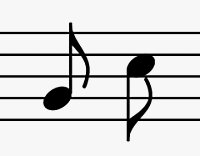Here are some basic note and rest values:
Without going into music theory, the above representations are correct in every way! If one were to turn the notes (not the rests) upside down, they would still be correct. The dots are always skewed as they are above, and the flags on the eighth and sixteenth notes always fly to the right:
Notes with flags ALWAYS have solid dots, or have x's instead of dots in the case of percussion.
The above notations are a far cry from this:
What is this? This is musical gibberish. Representations like this are about as ridiculous as making a bunch of random brush strokes on a piece of paper and calling it Chinese. Are those dots without stems and flags whole notes? Why are they all crammed on the page haphazardly? Why are some of the ledger lines purple, combined with their adjacent notes, and others yellow? As a musician, I have no idea. As an artist, I still have no idea.
Here's another example:
This one also falls under the category of fictitious instruments. Is it a clarinet? An oboe? A soprano sax? It has the attributes of all of them! But look at the notes... The first one checks out, but the one on the right is what I was talking about when I mentioned the fake Chinese earlier. It's gibberish, it means nothing. Obviously it was a sloppy attempt at an eighth note, but really? Some very BASIC research would have fixed this problem.
How about this:
Now, I'll admit that I don't know much about the musical notation associated with percussion, but I have never seen this note before! This is what I got when I googled "eighth note clip art". Unless I was asleep during the entire 14 years I was in school for music, I'm pretty sure this note doesn't exist! It's not a half note, and it's not an eighth note. The only way it could be worse is if it had a dot right after it and the flag was flying the wrong way. I'd describe this as a "half eighth note"... And "half eighth notes" do not exist.
In fact, here's a list of musical notation unique to percussion (click to see the whole thing):
I see no "half-eighth notes" here...
Graphic design is all about communication through imagery. Graphic designers who make unreadable images don't get work. Why, then, do so many designers and artists butcher musical notation? I'll grant that some artists will claim artistic license as a defense for their incorrect musical notation, and graffiti artists often distort text beyond the point of recognition. I respect artistic license and I have a deep love and respect for graffiti art, but even graffiti is readable. And if no artist in their right mind would butcher the beautiful characters of the Chinese language, why should they overlook the equally beautiful language of music?
I'm not saying that artists need to be 100% accurate with their musical notation, but please, one google search is all it takes to keep from embarrassing yourself in front of all of your musically inclined clients. Get a clue, folks. You wouldn't butcher the multitude of Asian, Ancient, Greek, or Cyrillic scripts, so stop making fools out of yourselves and learn what an eighth note looks like.
BTW, UA Presents... You might want to run your program artwork through a College of Music filter next year. Not to diss the artist, but this is EXACTLY what I'm talking about.






"Insightful" is the perfect word to describe this wonderful writing of yours. The artistic blend of this subject with your tone of writing made this a great read. Much love 😘.
ReplyDeleteDiaphragm
Sternum
Carpal Bones
Phalanges
Ulna
Radius
Scapula
Humerus
Clavicle